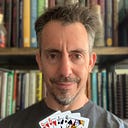Architects, Air Traffic Controllers and Orchestra Directors
Whenever there is a discussion about what role Product Managers play in an organization, the following Venn diagram seems to be close at hand:
Although I tend to agree that a Product Manager most often operates as a link between the various groups identified in the diagram above, this is really more of a positional representation of where a Product Manager fits in an organization, than the actual role that he or she plays within it.
Being a link between various groups and the role you play are not the same thing. A position tell you where you fit in. A role defines the functions and responsibilities that you assume.
As defined by the Merriam-Webster dictionary — a role is:
For example: Leadership is a role, not a position. As clearly stated by Donald McGannon’s quote, your position in an organization or team doesn’t inherently make you a leader. The role that you chose to play within your position does.
Whenever I get asked to explain what role a Product Manager plays in an organization, being a visual-thinker, I usually see them as performing the following three roles:
The Architect:
As an architect, I can go see an empty lot with my clients (i.e., users). While looking at the empty space in front of us, and the potential to create something amazing, I’ll ask them a series of questions to understand what they envision being built and for what purpose or specific problem that they are looking to solve (job-to-be-done).
Once I have enough information, requirements and a good understanding of the problem at hand, I’ll return to my studio, and while seating at my drafting table, I’ll start working on the blue prints.
When the blue prints (requirements documents — whichever form you choose) are completed, I’ll hand them over to my construction crew (UI/UX designers and developers), so they can start the actual work. But it’s the actual construction crew, brick and mortar in hand, who turn the architect’s vision into the actual product that’s delivered to the client. A consistent feedback loop between architects and crew is extremely important for the successful completion of the project.
The Air Traffic Controller:
As an air traffic controller my main, and most important job, is to direct the safety and efficiency of my team. I need to constantly be looking ahead and around trying to anticipate any possible obstacles and hazards that may get in their way, while identifying the optimal routes forward.
It’s a challenging game of balancing efficiency (different routes/delivering value to the users), with known risks (other planes in the sky/competing priorities and stakeholders) and unforeseen danger (approaching storms/changing market/business conditions/goals)
Ultimately, I am responsible for making sure to steer (clear vision and prioritization) my pilots (UI/UX designers and developers) around any potential risks so that they have a clear path to reach their destinations successfully (on-time and on-quality).
The Orchestra Director:
As an orchestra director, I don’t play any instruments myself. Instead, my job (i.e.: role) is to help each musician understands the vision for the composition so that they can play their individual instruments to their full potential; that as a section (for example: percussion =UI/UX designers, strings =developers and woodwinds = devops), they execute as good as they can and, finally, that they perform and sound, as a single cohesive unit (the entire orchestra = whole team/organization) simply amazing (deliver value to the user that helps drive the company towards it’s goals and vision).
This is truly a role of servant-leadership where the objective is to make the orchestra (i.e. team) shine bright and harmonious. In fact, if I’ve done my job well enough, come opening night, should I get hit by the proverbial “bus”, the orchestra shouldn’t skip a beat.
Now, on the surface, these three rolls are quite different and may not seem to have anything in common, but upon closer examination we can see a pattern emerging:
None of these roles, in and of themselves create a “product”. They don’t construct the buildings, fly the planes or play the instruments. What they do is:
- Architect: provide a clear vision and requirements of what the end goal looks like
- Air traffic controller: keep the team safe by removing obstacles and leading them safely to the desired destination
- Orchestra director: unify strong individual talent and making them perform as a single effective unit
One characteristic that can greatly help improve the chances of safely achieving the vision as one-team is that of great communication. All the roles identified above for a Product Manager require a complimentary team (construction crew, pilots and musicians) and a continues feedback loop to make sure that all parties are clear on priorities, challenges and objectives.
Overall, as Product Managers our job is one of: vision, communication, enablement and facilitation. And, sometimes, like Ken Norton likes to say, we simply bring the donuts!
May the Donuts be with you! :)
